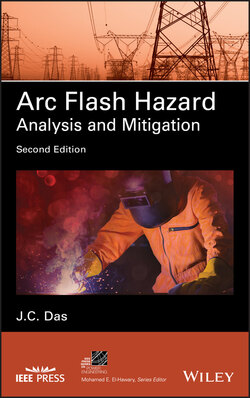Читать книгу Arc Flash Hazard Analysis and Mitigation - J. C. Das - Страница 30
1.10 HAZARD BOUNDARIES
ОглавлениеThe boundaries are defined in NFPA, and the following synopsis is relevant here (Figure 1.9).
The flash protection boundary is the distance at which the threshold of second-degree burns can occur and the incident energy release is 1.2 cal/cm2 (5.0 J/cm2). This is the boundary that is calculated by computer-based programs and IEEE Guide equations. Inside the boundary, the energy level will be higher. This boundary should not be crossed by any one, including a qualified person, without wearing the required PPE, (Table 1.8). The PPE outfits are designed to minimize the risk of sustaining energy greater than 1.2/cal cm2. That is, the threshold of second-degree burns can still occur even with appropriate PPE, and these burns are considered curable.
Unqualified persons, that is, those not specifically trained to carry out the required tasks, are safe when they stay away from the energized part of a certain distance, which is the limited approach boundary. They should not cross the limited approach boundary and arc flash boundary unless escorted by a qualified person.
Crossing the restricted approach boundary means that special shock prevention techniques and equipment are required, and an unqualified person is not allowed to cross this boundary. Finally, the prohibited approach boundary establishes the space that can be crossed only, as if a live contact with exposed energized conductors or circuits was planned.
Figure 1.9. Hazard boundaries around an arcing source, adapted from NFPA 70E. Source: Reference [17].
TABLE 1.9. Limited Approach and Restricted Approach Boundaries
Source: NFPA 70E [17]. © 2012 National Fire Protection Association. (All details in the NFPA table have not been reproduced.)
| System Voltage Range | Limited Approach Boundary | ||
| Phase-to-Phase | Exposed Movable Conductor (i.e., Overhead Line Conductors Supported on Poles) | Exposed Fixed Circuit Part | Restricted Approach Boundary, Included Inadvertent Movement Adder |
| Less than 50 V | Not specified | Not specified | Not specified |
| 50–300 V | 3.0 m | 1.0 m | Avoid contact |
| 301–750 V | 3.0 m | 1.0 m | 0.3 m |
| 751 V–15 kV | 3.0 m | 1.5 m | 0.7 m |
| 15.1–36 kV | 3.0 m | 1.8 m | 0.8 m |
| 36.1–46 kV | 3.0 m | 2.5 m | 0.8 m |
| 46.1–72.5 kV | 3.0 m | 2.5 m | 1.0 m |
| 72.6–121 kV | 3.3 m | 2.5 m | 1.02 m |
| 138–145 kV | 3.4 m | 3.0 m | 1.15 m |
The limited approach, restricted approach, and prohibited approach boundaries are all defined based upon the system voltage. No calculations are required for establishing these boundaries. Table 1.9 illustrates the limited approach and restricted approach boundaries based upon NFPA 70E.
